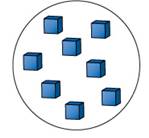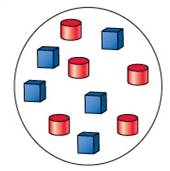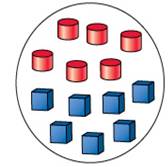
EBK CHEMISTRY
1st Edition
ISBN: 9780133888584
Author: Tro
Publisher: VST
expand_more
expand_more
format_list_bulleted
Concept explainers
Textbook Question
Chapter 1, Problem 33E
Each shape represents a type of particle (such as an atom or a molecule). Classify each image as a pure substance, homogeneous mixture, or heterogeneous mixture.
Expert Solution & Answer
Trending nowThis is a popular solution!

Students have asked these similar questions
In a system with an anodic overpotential, the variation of ŋ as a function of
the current density:
1. at low fields is linear 2. at higher fields, it follows Tafel's law
Find the range of current densities for which the overpotential has the same
value as when calculated for cases 1 and 2 (maximum relative difference of
5% with respect to the behavior for higher fields). To which overpotential
range does this correspond?
Data: 10 = 1.5 mA cm², T = 300°C, ẞ = 0.64, R = 8.314 J K 1 mol¹ and F = 96485
C mol-1.
Indicate 10.6 with only one significant figure.
If I have 10 data points for variables x and y, when I represent y versus x I obtain a line with the equation y = mx + b. Is the slope m equal to dy/dx?
Chapter 1 Solutions
EBK CHEMISTRY
Ch. 1 - Which statement is true about matter? a) Matter is...Ch. 1 - A chemist mixes sodium with water and witnesses a...Ch. 1 - Two samples of a compound containing elements A...Ch. 1 - A compound containing only carbon and hydrogen has...Ch. 1 - Which concept was demostrated by Rutherford’s gold...Ch. 1 - A student re-creates Millikan’s oil drop...Ch. 1 - Prob. 7SAQCh. 1 - An isotope of an element contains 82 protons and...Ch. 1 - How many electrons are in the Cr3+ ion? 24...Ch. 1 - A naturally occurring sample of an element...
Ch. 1 - Copper has an atomic mass of 63.55 amu and two...Ch. 1 - Which sample contains the greatest number of...Ch. 1 - Explain this statement in your own words and give...Ch. 1 - Explain the main goal of chemistry.Ch. 1 - What are two different ways to classify matter?Ch. 1 - How do solids, liquids, and gases differ?Ch. 1 - Explain the difference between a pure substance...Ch. 1 - Explain the difference between an element and a...Ch. 1 - Explain the difference between a homogeneous and a...Ch. 1 - Describe the scientific approach to knowledge. How...Ch. 1 - Prob. 9ECh. 1 - What observations did Antoine Lavoisier make? What...Ch. 1 - What theory did John Dalton formulate?Ch. 1 - What is wrong with the expression, “That is just a...Ch. 1 - Summarize the history of the atomic idea. How was...Ch. 1 - Prob. 14ECh. 1 - State and explain the law of definite proportions.Ch. 1 - State and explain the law of multiple proportions....Ch. 1 - What are the main ideas in Dalton’s atomic theory?...Ch. 1 - How and by whom was the electron discovered? What...Ch. 1 - Explain Millikan’s oil drop experiment and how it...Ch. 1 - Prob. 20ECh. 1 - Describe Rutherford’s gold foil experiment. How...Ch. 1 - Describe Rutherford’s nuclear model of the atom....Ch. 1 - If matter is mostly empty space, as suggested by...Ch. 1 - List the three subatomic particles that compose...Ch. 1 - What defines an element?Ch. 1 - Explain the difference between Z (the atomic...Ch. 1 - Where do elements get their names?Ch. 1 - What are isotopes? What is percent natural...Ch. 1 - Describe the two different notations used to...Ch. 1 - Prob. 30ECh. 1 - Prob. 31ECh. 1 - Explain how a mass spectrometer works. What kind...Ch. 1 - Each shape represents a type of particle (such as...Ch. 1 - Using triangles to represent one type of atom and...Ch. 1 - Classify each substance as a pure substance or a...Ch. 1 - Classify each substance as a pure substance or a...Ch. 1 - Prob. 37ECh. 1 - Complete the table. Substance Pure or mixture Type...Ch. 1 - Determine whether each molecular diagram...Ch. 1 - Determine whether each molecular diagram...Ch. 1 - Classify each statement as an observation, a law,...Ch. 1 - Classify each statement as an observation, a law,...Ch. 1 - A chemist decomposes several samples of carbon...Ch. 1 - When astronomers observe distant galaxies, they...Ch. 1 - Prob. 45ECh. 1 - An automobile gasoline tank holds 21 kg of...Ch. 1 - Two samples of carbon tetrachloride are decomposed...Ch. 1 - Two samples of sodium chloride are decomposed into...Ch. 1 - The mass ratio of sodium to fluorine in sodium...Ch. 1 - Upon decomposition, one sample of magnesium...Ch. 1 - Two different compounds containing osmium and...Ch. 1 - Palladium forms three different compounds with...Ch. 1 - Prob. 53ECh. 1 - Sulfur and fluorine form several different...Ch. 1 - Which statements are consistent with Dalton’s...Ch. 1 - Which statements are inconsistent with Dalton’s...Ch. 1 - Which statements are consistent with Rutherford’s...Ch. 1 - Which statements are inconsistent with...Ch. 1 - A chemist in an imaginary universe, where...Ch. 1 - Imagine a unit of charge called the zorg. A...Ch. 1 - Which statements about subatomic particles are...Ch. 1 - Which statements about subatomic particles are...Ch. 1 - Write isotopic symbols in the form XA (e g., C-13)...Ch. 1 - Write isotopic symbols in the form ZAX for each...Ch. 1 - Determine the number of protons and the number of...Ch. 1 - Determine the number of protons and the number of...Ch. 1 - The amount of carbon-14 in ancient artifacts and...Ch. 1 - Uranium-235 is used in nuclear fission. Determine...Ch. 1 - Determine the number of protons and the number of...Ch. 1 - Determine the number of protons and the number of...Ch. 1 - Gallium has two naturally occurring isotopes with...Ch. 1 - Magnesium has three naturally occurring isotopes...Ch. 1 - The atomic mass of fluorine is 18.998 amu, and its...Ch. 1 - The atomic mass of copper is 63.546 amu. Do any...Ch. 1 - An element has two naturally occurring isotopes....Ch. 1 - An element has four naturally occuring isotopes...Ch. 1 - Bromine has two naturally occurring isotopes...Ch. 1 - Silicon has three naturally occurring isotopes...Ch. 1 - Use the mass spectrum of europium shown here to...Ch. 1 - Use the mass spectrum of rubidium shown here to...Ch. 1 - A 7.83-g sample of HCN contains 0.290 g of H and...Ch. 1 - The ratio of sulfur to oxygen by mass in SO2 is...Ch. 1 - Use the mass spectrum of lead shown here to...Ch. 1 - Use the mass spectrum of mercury shown here to...Ch. 1 - Nuclei with the same number of neutrons but...Ch. 1 - Fill in the blanks to complete the table. Symbol z...Ch. 1 - Silver is composed of two naturally occurring...Ch. 1 - To the right is a representation of 50 atoms of a...Ch. 1 - The ratio of oxygen to nitrogen by mass in NO2 is...Ch. 1 - Naturally occurring cobalt consists of only one...Ch. 1 - A 7.36-g sample of copper is contaminated with an...Ch. 1 - The ratio of the mass of O to the mass of N in...Ch. 1 - Naturally occurring magnesium has an atomic mass...Ch. 1 - A volatile liquid (one that readily evaporates) is...Ch. 1 - The diagram to the right represents solid carbon...Ch. 1 - Use triangles to represent atoms of element A and...Ch. 1 - Identify each statement as being most like an...
Knowledge Booster
Learn more about
Need a deep-dive on the concept behind this application? Look no further. Learn more about this topic, chemistry and related others by exploring similar questions and additional content below.Similar questions
- The data for the potential difference of a battery and its temperature are given in the table. Calculate the entropy change in J mol-1 K-1 (indicate the formulas used).Data: F = 96485 C mol-1arrow_forwardIn a cell, the change in entropy (AS) can be calculated from the slope of the E° vs 1/T graph. The slope is equal to -AS/R, where R is the gas constant. Is this correct?arrow_forwardUsing the Arrhenius equation, it is possible to establish the relationship between the rate constant (k) of a chemical reaction and the temperature (T), in Kelvin (K), the universal gas constant (R), the pre-exponential factor (A) and the activation energy (Ea). This equation is widely applied in studies of chemical kinetics, and is also widely used to determine the activation energy of reactions. In this context, the following graph shows the variation of the rate constant with the inverse of the absolute temperature, for a given chemical reaction that obeys the Arrhenius equation. Based on the analysis of this graph and the concepts acquired about the kinetics of chemical reactions, analyze the following statements: I. The activation energy (Ea) varies with the temperature of the system. II. The activation energy (Ea) varies with the concentration of the reactants. III. The rate constant (K) varies proportionally with temperature. IV. The value of the…arrow_forward
- In an electrolytic cell, indicate the formula that relates E0 to the temperature T.arrow_forward-- 14:33 A Candidate Identification docs.google.com 11. Compound A can transform into compound B through an organic reaction. From the structures below, mark the correct one: HO A تھے۔ די HO B ○ A) Compounds A and B are isomers. B) Both have the same number of chiral carbons. C) Compound A underwent an addition reaction of Cl2 and H2O to form compound B. D) Compound A underwent a substitution reaction forming the intermediate chlorohydrin to obtain compound B. E) Compound A underwent an addition reaction of Cl2 forming the chloronium ion and then added methanol to obtain compound B. 60arrow_forward-- 14:40 A Candidate Identification docs.google.com 13. The compound 1-bromo-hex-2-ene reacts with methanol to form two products. About this reaction, mark the correct statement: OCH3 CH3OH Br OCH3 + + HBr A B A) The two products formed will have the same percentage of formation. B) Product B will be formed by SN1 substitution reaction with the formation of an allylic carbocation. C) Product A will be formed by SN1 substitution reaction with the formation of a more stable carbocation than product B. D) Product A will be formed by an SN2 substitution reaction occurring in two stages, the first with slow kinetics and the second with fast kinetics. E) The two compounds were obtained by addition reaction, with compound B having the highest percentage of formation. 57arrow_forward
- -- ☑ 14:30 A Candidate Identification docs.google.com 10. Amoxicillin (figure X) is one of the most widely used antibiotics in the penicillin family. The discovery and synthesis of these antibiotics in the 20th century made the treatment of infections that were previously fatal routine. About amoxicillin, mark the correct one: HO NH2 H S -N. HO Figura X. Amoxicilina A) It has the organic functions amide, ester, phenol and amine. B) It has four chiral carbons and 8 stereoisomers. C) The substitution of the aromatic ring is of the ortho-meta type. D) If amoxicillin reacts with an alcohol it can form an ester. E) The structure has two tertiary amides. 62arrow_forwardThe environmental police of a Brazilian state received a report of contamination of a river by inorganic arsenic, due to the excessive use of pesticides on a plantation on the riverbanks. Arsenic (As) is extremely toxic in its many forms and oxidation states. In nature, especially in groundwater, it is found in the form of arsenate (AsO ₄ ³ ⁻ ), which can be electrochemically reduced to As ⁰ and collected at the cathode of a coulometric cell. In this case, Potentiostatic Coulometry (at 25°C) was performed in an alkaline medium (pH = 7.5 throughout the analysis) to quantify the species. What potential (E) should have been selected/applied to perform the analysis, considering that this is an exhaustive electrolysis technique (until 99.99% of all AsO ₄ ³ ⁻ has been reduced to As ⁰ at the electrode, or n( final) = 0.01% n( initial )) and that the concentration of AsO ₄ ³ ⁻ found in the initial sample was 0.15 mmol/L ? Data: AsO ₄ 3 ⁻ (aq) + 2 H ₂ O ( l ) + 2 e ⁻ → A s O ₂ ⁻ ( a…arrow_forward-- 14:17 15. Water-soluble proteins are denatured when there is a change in the pH of the environment in which they are found. This occurs due to the protonation and deprotonation of functional groups present in their structure. Choose the option that indicates the chemical bonds modified by pH in the protein represented in the following figure. E CH2 C-OH CH2 H₂C H₁C CH CH3 CH3 CH CH₂-S-S-CH₂- 910 H B -CH2-CH2-CH2-CH₂-NH3* −0—C—CH₂- ○ A) A, C e D. • В) Вес ○ C) DeE ○ D) B, De E ○ E) A, B e C 68arrow_forward
- Suppose sodium sulfate has been gradually added to 100 mL of a solution containing calcium ions and strontium ions, both at 0.15 mol/L. Indicate the alternative that presents the percentage of strontium ions that will have precipitated when the calcium sulfate begins to precipitate. Data: Kps of calcium sulfate: 2.4x10 ⁻ ⁵; Kps of strontium sulfate: 3.2x10 ⁻ ⁷ A) 20,2 % B) 36,6 % C) 62,9 % D) 87,5 % E) 98.7%arrow_forward14:43 A Candidate Identification docs.google.com 14. The following diagrams represent hypothetical membrane structures with their components numbered from 1 to 6. Based on the figures and your knowledge of biological membranes, select the correct alternative. | 3 5 || 人 2 500000 6 A) Structures 1, 3, 5, 2 and 4 are present in a constantly fluid arrangement that allows the selectivity of the movement ○ of molecules. Structure 4, present integrally or peripherally, is responsible for this selection, while the quantity of 6 regulates the fluidity. B) The membranes isolate the cell from the environment, but allow the passage of water-soluble molecules thanks to the presence of 2 and 3. The membrane in scheme is more fluid than that in 55arrow_forward12. Mark the correct statement about reactions a and b : a. Br + -OH Br b. + Br H₂O + Br -OH + H₂O A) The reactions are elimination reactions, with reaction "a" being of type E2 and reaction "b" being of type E1. B) Reaction "a" is an E2 type elimination occurring in one step and reaction "b" is an SN1 type substitution. C) Both reactions can result in the formation of carbocation, but in reaction "b" the most stable carbocation will be formed. D) Both reactions occur at the same rate ○ and have the same number of reaction steps. E) Reaction "b" is an E2 type elimination occurring in two steps and reaction "a" is an SN2 type substitution.arrow_forward
arrow_back_ios
SEE MORE QUESTIONS
arrow_forward_ios
Recommended textbooks for you
 Chemistry: The Molecular ScienceChemistryISBN:9781285199047Author:John W. Moore, Conrad L. StanitskiPublisher:Cengage Learning
Chemistry: The Molecular ScienceChemistryISBN:9781285199047Author:John W. Moore, Conrad L. StanitskiPublisher:Cengage Learning General, Organic, and Biological ChemistryChemistryISBN:9781285853918Author:H. Stephen StokerPublisher:Cengage LearningChemistry: Matter and ChangeChemistryISBN:9780078746376Author:Dinah Zike, Laurel Dingrando, Nicholas Hainen, Cheryl WistromPublisher:Glencoe/McGraw-Hill School Pub Co
General, Organic, and Biological ChemistryChemistryISBN:9781285853918Author:H. Stephen StokerPublisher:Cengage LearningChemistry: Matter and ChangeChemistryISBN:9780078746376Author:Dinah Zike, Laurel Dingrando, Nicholas Hainen, Cheryl WistromPublisher:Glencoe/McGraw-Hill School Pub Co Introductory Chemistry: A FoundationChemistryISBN:9781337399425Author:Steven S. Zumdahl, Donald J. DeCostePublisher:Cengage Learning
Introductory Chemistry: A FoundationChemistryISBN:9781337399425Author:Steven S. Zumdahl, Donald J. DeCostePublisher:Cengage Learning World of Chemistry, 3rd editionChemistryISBN:9781133109655Author:Steven S. Zumdahl, Susan L. Zumdahl, Donald J. DeCostePublisher:Brooks / Cole / Cengage Learning
World of Chemistry, 3rd editionChemistryISBN:9781133109655Author:Steven S. Zumdahl, Susan L. Zumdahl, Donald J. DeCostePublisher:Brooks / Cole / Cengage Learning Living By Chemistry: First Edition TextbookChemistryISBN:9781559539418Author:Angelica StacyPublisher:MAC HIGHER
Living By Chemistry: First Edition TextbookChemistryISBN:9781559539418Author:Angelica StacyPublisher:MAC HIGHER

Chemistry: The Molecular Science
Chemistry
ISBN:9781285199047
Author:John W. Moore, Conrad L. Stanitski
Publisher:Cengage Learning

General, Organic, and Biological Chemistry
Chemistry
ISBN:9781285853918
Author:H. Stephen Stoker
Publisher:Cengage Learning

Chemistry: Matter and Change
Chemistry
ISBN:9780078746376
Author:Dinah Zike, Laurel Dingrando, Nicholas Hainen, Cheryl Wistrom
Publisher:Glencoe/McGraw-Hill School Pub Co

Introductory Chemistry: A Foundation
Chemistry
ISBN:9781337399425
Author:Steven S. Zumdahl, Donald J. DeCoste
Publisher:Cengage Learning

World of Chemistry, 3rd edition
Chemistry
ISBN:9781133109655
Author:Steven S. Zumdahl, Susan L. Zumdahl, Donald J. DeCoste
Publisher:Brooks / Cole / Cengage Learning

Living By Chemistry: First Edition Textbook
Chemistry
ISBN:9781559539418
Author:Angelica Stacy
Publisher:MAC HIGHER
Types of Matter: Elements, Compounds and Mixtures; Author: Professor Dave Explains;https://www.youtube.com/watch?v=dggHWvFJ8Xs;License: Standard YouTube License, CC-BY



